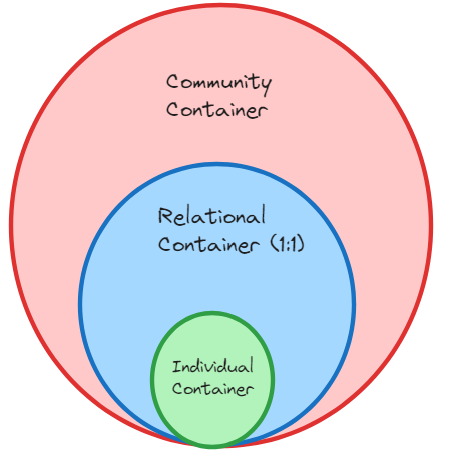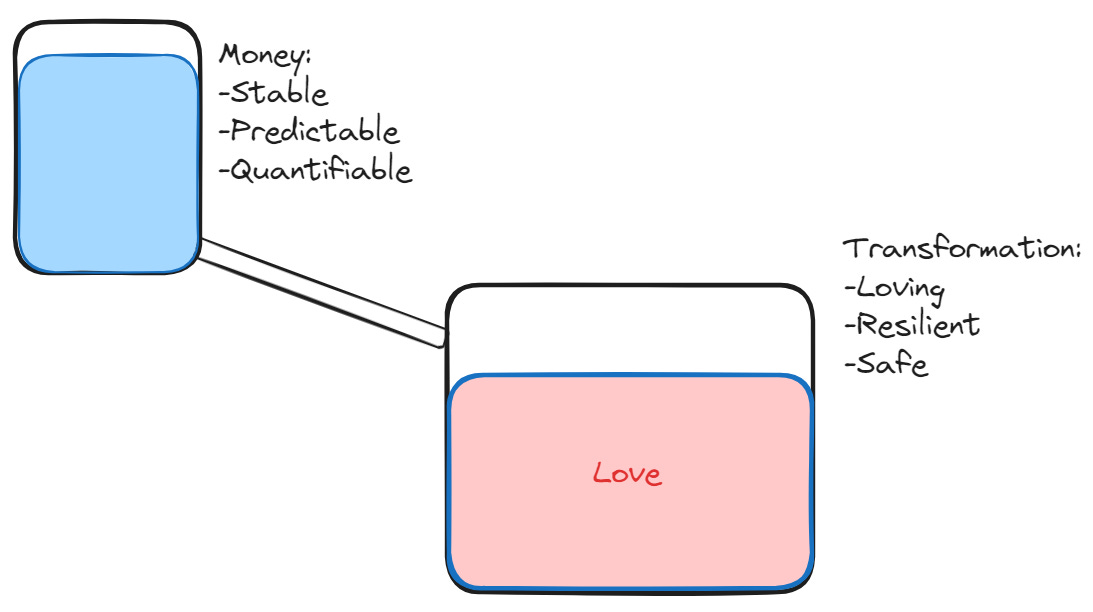Where's all the Money in Personal Transformation?
Why are rich people sad and spiritual people poor?
[This article has a 7/10 Woo Rating]
I’ve spent the last 20 years working in the City of London, on Wall Street and in Ultra-High-Net-Worth wealth management. To be honest, financial markets have never really interested me, but the people always have. For the last few years I’ve been focused on the relationship between wealth and personal transformation.
Now I’m in my mid 40s, many people I know have reached the top of their own personal “success mountain” and are looking around for what’s next. Once you’ve hit that peak, virtually no amount of material success will make you any happier. So one healthy approach is to pursue the path of personal transformation. The relationship of money to that path is incredibly interesting.
In the last three years I’ve met well over a hundred people doing interesting, exciting and meaningful work in facilitating personal transformation. Many of them are living in some degree of financial insecurity. In contrast, I know an enormous number of people with generational wealth and a ravenous appetite for personal evolution. This disconnect represents an extraordinary opportunity for those that can unlock the flow.
One morning last month I went to the trendy new Bathhouse spa in Manhattan. As I wandered between the different-sized hot and cold pools, I had a moment of revelation. We need to be thinking in terms of containers.
The container on the left is the trillions of dollars lying stagnant in bank accounts. The container on the right is the personal transformation industry. The container on the left is full to the brim. It’s solid and full of clear liquid. We can each see exactly how much money we have. It brings us security, optionality and predictability. But, as EarthElder Mindahi Bastida remarked to me recently, “water that doesn’t flow starts to stink.” Once they have reached the top of success mountain, people tend to get stuck. I believe this is less of a shameful crisis, but more of a natural developmental stage, where we move into more a meaningful life.1 This risky transition often requires a radical shift in focus, and is best undertaken with the help of genuine experts. Money can really help with that.
Moreover, for better or worse, this is the first time in modern history you have an unusually large number of influential and powerful people suddenly becoming more “spiritually aware” through the widespread usage of psychotechologies and psychedelics. Many of them desperately need help grounding and integrating those experiences. Especially once they realise they urgently need to change their life path.
So why is money so allergic to the personal transformation industry? The problem is that the righthand container is often leaky. The value provided by transformational practices and practitioners can be unreliable and vague. Even the word spirituality itself can be fuzzy and alienating. How do I know if breathwork or somatic meditation or Internal Family Systems is right for me? What does it mean if it “works”? The water is often murky too: is the practitioner well-trained, ethical, or riddled with their own shadows and complexes? How would I know? If I pour my hard-earned crystalline waters of wealth into that murky, leaky container will it simply trickle away tainted? No, it’s better to play it safe in case that rainy day comes.
The question any hard-nosed capitalist is entitled to ask when paying for personal transformation is “what do I get in return for my money?”
In order to heal the relationship between money and spirituality we need to focus on fixing the right-hand container.
For those looking to build or find a powerful transformational container you can see it as a nested set of 3 levels:
Individual
Relational
Communal
1. The Individual Container.
If you’re planning to work in personal transformation, or to start working on your own consciousness, it helps to start looking at yourself as a container. Since I founded The Leading Edge I have been overwhelmed with abundance. I have also attracted other practitioners at the top of their respective games. I spent a few months this year working with “Teacher of Presence” Roshni Daya. My conversation with her formed the culmination of this year’s Accelerating Wisdom Series, where I concluded that “presence” is one of the prizes of pursuing wisdom.
Roshni spent years examining her internal discomfort as her son suffered with the skin disorder vitiligo. It gave her an unusually expansive sense of how her internal world was responding to external events. Over time this allowed her to intuit what was going on in others’ bodies and discern the source of their own issues. Because her own body was so clear she could hold that expansive space for others. This connection and intimacy was so at-odds with the clinical detachment preached by the mental health industry that she felt it was no longer compatible with her career as a psychologist. I personally worked with her for seven sessions to get a sense for her process and abilities. At the end of the first session we talked around some issues I have around the role of money and power in my life. She said to me: “my intuition is that it’s about your gut.”
The very next day I got some random bloodwork back and was diagnosed with pre-diabetes. It was a pretty big shock. I eat fine, I’m not overweight and I spar pretty intensely four times a week. But I also realized I’ve been asking the universe for discernment. In my new role I help powerful people who are unsure of how to make sense of their overwhelming spiritual experiences. I need to learn how to feel truth in what I hear and read. I need to have exceptional judgment about which new members and practitioners I allow in the community. It’s already a group filled with unusually driven people, and that comes with its own challenges.
The night before my next session with Roshni I dreamed that something incredibly scary was trying to get into our house. But we had enough dried food stored up so everything would be fine. The next morning I woke up and remembered something that came out of my research for our episode on dreamwork: sometimes you are everyone in the dream. I wasn’t just the scared man in the house, I was also the scary person trying to get in. To me, this represented my disowned shadow.
When I told this to Roshni, we both noticed that I simply couldn’t feel my gut. The space from my solar plexus to my pelvis was a void. Nothing good or bad, just blank. I realized I don’t necessarily eat unhealthily, but I overpower my gut. The spiciest food, sugar, strong flavors. Roshni challenged me to set a reminder to feel my gut eight times a day. I now believe that the pre-diabetes was a prompt, a gift, to force me to seriously address my diet. Thankfully I’ve managed to reverse it after a few months of disciplined eating.
More than anything else in the world I want my community to be a container that is filled with love. And I realized I wasn’t even treating my own container, my body, with love.
Moreover, your gut is often the center of your power. In martial arts your “soft belly” below your solar plexus, or the “hara”, is the vital center of the body as well as your centre of gravity. It literally helps ground you. The risk specific of my own shadow is that I amplify the voices of dangerous charlatans who sound smart. Or worse, use my own voice to manipulate and sound clever without engaging my heart. Both of those can be mitigated with a better sense of my own embodied truth: my gut. Meanwhile the idea that “I’m everyone in the dream”, including in my waking life, has been subtly transformational. I am better at paying attention to who really triggers me and why. In that sense, I can actually count myself lucky that so many public figures exemplify “all tongue, no heart.” It gives us a clear example of what we need to avoid most within ourselves.
But when it comes to transformational containers, there’s simply only so much we can do on our own. Which is why we need to apply the same concept to therapeutic relationships.
2. The Relational Container.
Brian Whetten was an early founder in Silicon Valley in the 90s. Two burnouts later, he has spent the last 23 years reverse-engineering spiritual technologies. My recent conversation with him was one of the most interesting and insightful I’ve ever had.
Brian argues that truly adept spiritual practitioners don’t focus on generating the highest peak state experiences for their clients. It’s very tempting to offer wealthy clients a luxury Costa Rican retreat with very strong substances in order to provide rapid, tangible “value for money.” The 26 year-old shaman from New Jersey offering you a decade of therapy in one DMT session is a legacy of the old achievement mindset of proving your worth through immediately quantifiable results. It also comes from a fear that you’re not providing enough “value” yourself.
Instead the enduring transformational value is more likely to come in a strong and loving therapeutic relationship. This requires a high capacity to hold and manage the emotions, thoughts, and experiences of ourselves and others. Therapy-speak describes this as “holding space”: our ability to be fully loving and present with others. Our container needs to be strong enough to hold difficult content, big enough to deal with powerful egos and clean of shadow to prevent us projecting our unresolved issues on others. Once difficult trauma or shadow comes up in that kind of safe relationship it can dissolve away. As Roshni also discovered, this kind of intimacy is often at odds with the professional therapy and (especially) psychiatry industry that preaches emotional detachment from clients. This means that those looking for a transformational relationship should seek out partners that can hold loving presence. In his book, On Becoming A Person, American humanist psychologist Carl Rogers wrote that:
“The self-awareness and human presence of the therapist is more important than the therapist’s technical training… If I can provide a certain type of relationship, the other person will discover within himself the capacity to use that relationship for growth, and change and personal development will occur.”
Literally heartless A.I. therapist chatbots are going to find that difficult.
When I first met Brian he told me something that has stuck with me for months “you can only see as much in yourself as someone else can see in you.” As you gain spiritual power your container expands: you gain greater awareness. Then you can see more of others, and bring their shadow into the light with them. But you then need someone who can see more of you: especially your blindspots. The risk is that you think your container is stronger and cleaner than it is, this leads to you taking on far more than you can actually handle too soon.
As Brian emphasizes: healing is not an act of self-help, intelligence or willpower. It’s a spiritual and psychological process best done in a loving community or partnership. One person holds the light while the other goes into their darkness.
3. The Communal Container.
Pretty much everything that applies to individuals as containers also applies to communities. Robust transformational communities need to be resilient. There’s overwhelming evidence that everything starts falling apart above Dunbar’s number of 150 people. If everyone knows everyone else, you have higher levels of trust and accountability. The container also needs to be clean. In Brian’s considerable experience, he believes the vast majority of “spiritual” organizations and individuals fail due to hidden traps set by shadow. The quality of the members, practices and practitioners need to be ruthlessly maintained. Only a little bit of dirt can muddy the water.
This is what I’ve tried to build at The Leading Edge. This may sound like an advertisement, but it isn’t. The network is effectively at capacity. What this actually is is a recommendation to go and start or join one of these containers yourself. Then we can share scalable resources, practices and practitioners. Since I started the network I’ve been approached by multiple different groups with different goals and membership types.
This “network of tribes” is unquestionably one of the futures of capitalism.2 There is a tsunami of money and power waiting to be unleashed. But it simply will not flow into containers that cannot hold it. The spiritual-industrial complex is littered with catastrophic examples of those that have tried before they were ready.
Instead, the highest purpose of wealth that I’ve encountered is as a container for personal experiments.3 It gives us the space and freedom to pursue what we love. And love, once again, is the key.4 Within your own body, the purpose isn’t to repress the pain you feel, it’s to find ways to love it. Love is the key ingredient in a therapeutic relationship. And in an organization, love between members keeps the group strong. In all three, love is the solvent that dissolves any shadow that manages to find its way into the container.
What does this have to do with money?
An appropriate indication of Brian and Roshni’s value is that they both taught me incredibly profound things about containers. And they both charge ten times what I would be able to personally afford. I was lucky to be connected with both through my work at Leading Edge. To be absolutely clear: a high price doesn’t guarantee transformational value, but it can sometimes be a directional indicator of competence.
It’s obviously naive to assume that those with the strongest container always make the most money. But it’s equally dangerous to try to take on too much without one. Powerful, wealthy people can manipulate you, or your organization, without even realizing they are doing it. As our awareness expands and our consciousness becomes more integrated our own container becomes larger. As we resolve our our own shadow, the water becomes cleaner. Once your container is larger and cleaner it can hold more. This eventually allows it to take on the money, energy and power that comes from working with billonaires and celebrities without becoming corrupted or overwhelmed.
Whether or not this directly leads to more money, that increased capacity for power and awareness also leads to an increase in the love we can give and receive. Three ways to think about that process are:
Personal: do everything you can to make sure you are aware and present. The “how” of this was the primary takeaway from my Accelerating Wisdom Series.
Relational: find a loving therapeutic relationship with someone more aware than you and with less shadow.
Communal: Find, found or cultivate a loving community. I wrote recently about an amazing tool to assess the strength and size of your own interpersonal community.
Money has assumed so much importance in our culture because of the absence of strong social supports. We fear if we lose our money we won’t be safely held. But a truly loving container you can rely on is an even more solid foundation.
See my interview with Devin Martin on managing life transitions.
See my article The Future of Capitalism is Sageism
My interview with Anne Laure Le Cunff provides specific details.









Woo rating! This, methinks, needs an emoji we can "click" next to the heart. Thanks for the insightful work.
Fascinating idea, of a disowned shadow. You could write about that sometime?